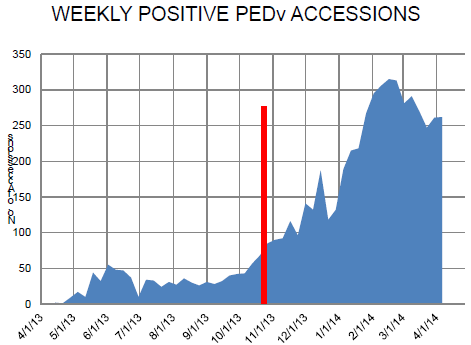



CME: PED, Swine Delta Coronavirus Now Reportable Diseases
US - USDA announced on Friday that it would require reporting of Porcine Epidemic Diarrhoea Virus (PEDv) and Swine Delta Coronavirus (SDCv) cases to federal officials, write Steve Meyer and Len Steiner.Farm identities and locations will be required of herds and will be recorded by animal health laboratories when diagnostic samples are received. They will also be entered into a monitoring and control programme that is still being designed. According to a USDA factsheet, USDA will provide funding to help states verify that the required biosecurity and herd-level control practices are followed.
A statement by Secretary of Agriculture Tom Vilsack said that the programme will also require tracking of the movements of pigs, vehicles and other equipment leaving infected premises but that pig movement would still be allowed.
Without knowing the details of the monitoring and control programme, it is difficult to gauge what its impact may be on hog and pork markets. In the long run, we would expect a successful programme to reduce the level of death losses, of course, but the more important short run impact would hopefully be a better accounting for the number of pigs that are being lost.
Knowing a farm identity and location may well help in that effort but there is no mention in either the factsheet or Mr Vilsack’s statement that data on pig losses will be included. Further, we must remember that by far the largest supply impacts of this disease are six months into the future so any enhancement of loss data today (and the programme doesn’t appear to be ready today!) would clarify expected harvest numbers in late October. The cavalry may be coming but they aren’t here yet.
Meanwhile, the latest data from USDA’s National Animal Health Diagnostic Laboratory Network shows 262 positive case accessions for the week that ended 12 April. That is one more accession than the previous week and 15 more than during the week of 29 March. That week’s 247 is the lowest number observed since late January.
We would still consider the number of new cases as being on a downtrend but the observations of the past two weeks may have slowed its pace. Fewer new cases had been expected as temperatures rise since viruses, in general, survive less readily outside of a host in warmer temperatures.
The higher accession totals of the past two weeks were driven by a general slowing of the downtrends for several major PEDv-infected states and several small increases in states that have seen fewer cases thus far.
The only exceptions to that statement would be a 7-accession jump for Michigan the week ending 5 April and a 5-accession jump for Oklahoma for the week ending 12 April. Case accessions in Minnesota have grown from 40 to 51 over the past three weeks while case accessions in Iowa and Illinois have held constant at roughly 50 and 42, respectively the past three weeks.
It may be notable that Minnesota’s accessions for 12 April were more numerous than were those for Iowa, marking the first time since late October that any state had more accessions than Iowa. Note that last week’s slaughter, which was down 6.2 per cent from one year ago, came from pigs born at about the time represented by the red vertical line. There appear to be more yr/yr shortfalls to come.

Correction: Following our report on broiler production trends on Thursday, we were alerted to the fact that USDA had revised its figures for 2013 as part of its annual statistical review. As a result, the year/year comparisons now look quite a bit different than before.
Based on this revision, broiler chick placements for the week ending 12 April were down 1.1 per cent for the 19 state area and down 1.4 per cent for the total US. Since 1 March, total US broiler placements have averaged 0.7 per cent below year ago, a decline that significantly changes the outlook for US broiler supplies going into the spring. A revised chart appears below. The last data point on this chart is for the week that ended 12 April .









